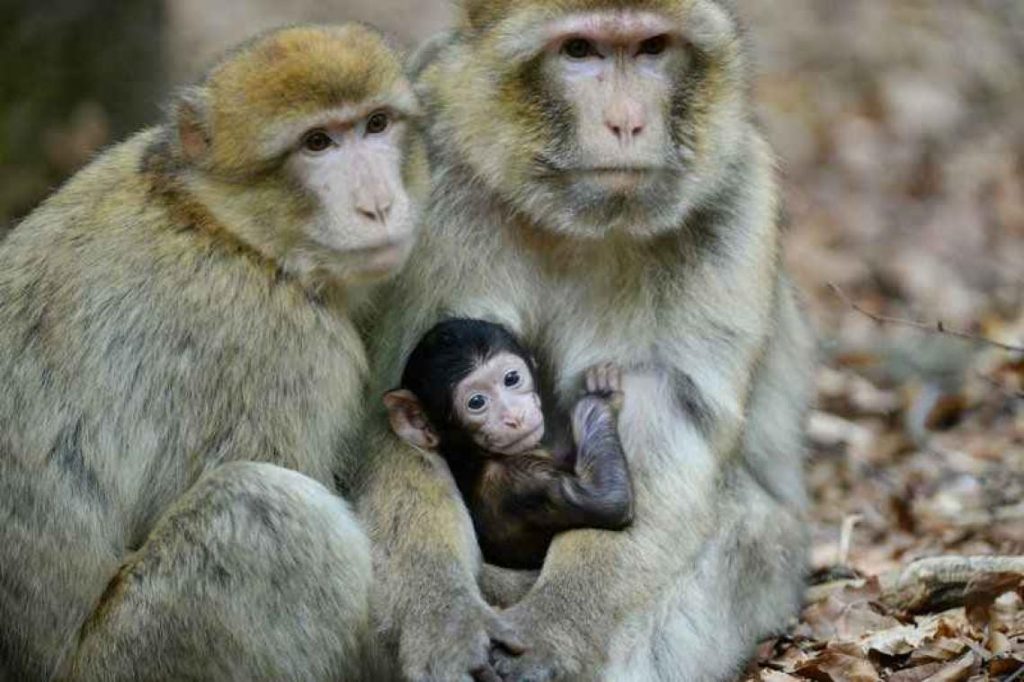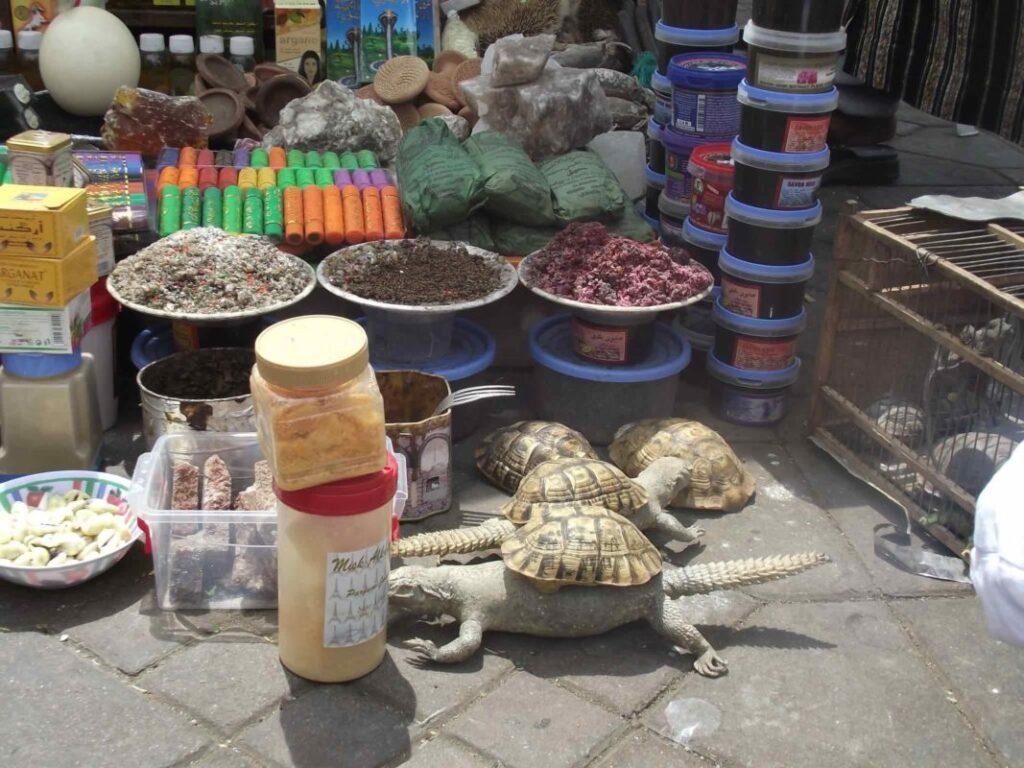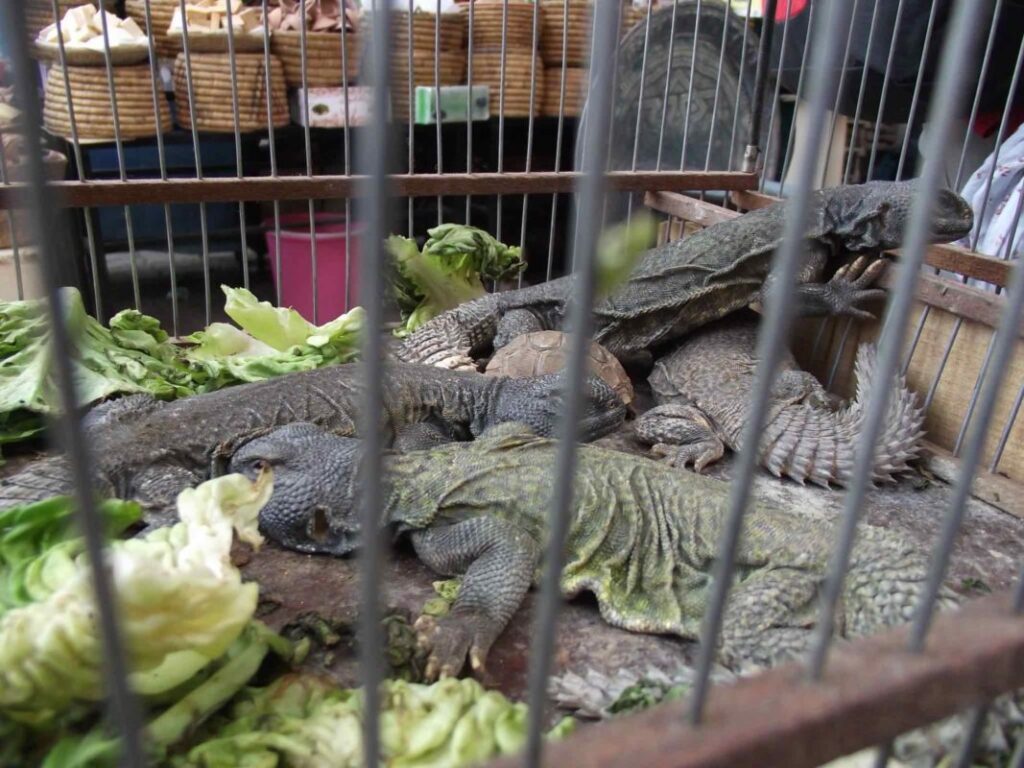האגודה ההומנית של מרוקו מבינה את הצורך הקשה במאמצי השימור המקומיים והבינלאומיים שיועסקו על ידי ארגונים מוסמכים, על מנת להקל על הרס בתי גידול והכחדת מינים.
מיני חיות הבר בסכנת הכחדה במרוקו כוללים את נמר ברברי, וולדרפ, חותם נזיר ים תיכוני, צבוע ברברי, קובייר גזלה והנשר הקיסרי הספרדי.

סוגיות חיות בר וסחר במרוקו מהווים אתגרים משמעותיים לשימור המגוון הביולוגי ורווחת בעלי חיים. למרות המאמצים להגן על מיני חיות הבר הילידים, סחר בחיות הבר הבלתי חוקיות נותר דאגה דוחקת, מונע על ידי ביקוש לחיות מחמד אקזוטי, רפואה מסורתית ומוצרי יוקרה.
אחד הנושאים העיקריים של חיות הבר במרוקו הוא שיטוף של מינים בסכנת הכחדה. פעילויות שיטור, המונעות על ידי הביקוש הבינלאומי למוצרי חיות בר, מאיימות על הישרדותם של מינים איקוניים אלה ומשבשות מערכות אקולוגיות שבריריות.
בנוסף, סחר בציפורים, זוחלים ובעלי חיים אקזוטיים אחרים לסחר בחיות מחמד נפוץ במרוקו. רבים מבעלי החיים הללו נלכדים מהטבע ומוברח על גבולות, מה שמוביל לירידות אוכלוסייה וחוסר איזון אקולוגי. יתרה מזאת, סחר חיות הבר הבלתי חוקי כרוך לעתים קרובות באכזריות וניצול, כאשר בעלי חיים נתונים למתח, פציעה וטיפול לא אנושי במהלך לכידה, הובלה ומכירה.
כדי להילחם בסחר בחיות הבר במרוקו, יש צורך במאמצים מתואמים לחיזוק אכיפת החוק, לשפר את המודעות הציבורית ולקדם אלטרנטיבות בר -קיימא לשימוש במוצרי חיות בר. שיתוף פעולה בין סוכנויות ממשלתיות, ארגונים לא ממשלתיים וקהילות מקומיות חיוני כדי לטפל בסיבות השורש לסחר בחיות הבר ולהגן על המגוון הביולוגי לדורות הבאים.
האגודה ההומנית של מרוקו שואפת להעלות את המודעות לנושאי חיות הבר וסחר במרוקו, ומספקת מידע על יוזמות שימור, מנגנוני דיווח על פשעי חיות בר ודרכים לאנשים להיות מעורבים במאמצי הגנת חיות הבר.
יחד, אנו יכולים לפעול לעתיד בו חיות הבר משגשגות בבתי הגידול הטבעיים שלהם, נטולי איום של ניצול וסחר.

ברבים מאלפי החנויות הקווים את רחובות המדינות של מרוקו, הקונים יכולים למצוא חנויות הנקראות "צמחי מרפא" המתמחים בעשבי תיבול, תבלינים, שמנים ותרופות מסורתיות.
זוחלים וחלקיהם נמצאים לרוב בחנויות אלה, תרגול הנמשך מהעבר ההיסטורי של מרוקו. חשבונות התרופות המסורתיות של מרוקו מתוארכות עד 1810 - ג'יימס גריי ג'קסון תיאר, בשפה צבעונית, את התרגול של זיקיות בוער:
"איכויות רפואיות שונות מוקצות לבשרו של הזיקית, והשפעות גחמניות רבות מיוחסות לחיטוש איתו כאשר הם מיובשים. אנשים מתווכחים יש להם חוזר, והיא נמכרת בהתאם לכל חנויות התרופות במרוקו. הריח הנובע מהמיאוש הוא ללא אמצעים אסיר תודה, אלא שההשפך ימנע מהשילוי של האלקטרס, מה שמסעד את האלקטרס, מה שמסעד את האלקטרס, מה שמספר את האלקטרס, מה שמסעד את האלקטרסציה של האלקטרון הוא" Aprestiati thing thation assud that sperstial assud that spresta and supprist sprestan an Sprestan. לחוסר אונים! "
למרות זאת, וחשבונות אחרונים אחרים, אף מחקרים קודמים לא כימתו את מספר בעלי החיים המשמשים במרוקו למטרות רפואיות. כדי לחקור את סחר הזוחלים לפרקטיקות רפואיות, מחקר ביצע 49 סקרים של 20 עיירות וערים במרוקו. צוין נוכחותם של כל מינים פראיים שנמצאו בשווקים, ובמידת האפשר, אסף מידע על השימושים, המחזור והמוצא שלהם.

יותר מ -1,500 דגימות של לפחות 9 מיני זוחלים ב -14 ערים ועיירות נספרו. מרקש וקזבלנקה הכילו את הדגימות הרבות ביותר עם 163 ו -86 בממוצע לכל סקר בכל עיר, בהתאמה. הדגימות שנצפו, יחד מייצגות באזור של סחורות בשווי 100,000 דולר. החיות הנפוצות ביותר היו זיקיות ים תיכוניות והלטאות של בל, מכרו הן בשידור חי והן במיסוי. יישומים מסורתיים של חיות בר במרוקו משלבות שימושים תרבותיים, מיסטיים ורפואיים. השימושים בבעלי חיים דווחו כמגוונים, אך משקפים את השימושים המסורתיים של העבר. זיקיות נמכרו לרוב מיובשות ונתפסו כדי להגן מפני מגוון מחלות, מכאבי ראש לעין הרעה (מבט של אדם שאמור להפעיל קללה או מזל רע). לטאות Dabb של Bell ממולאות ממוקמות בפינת בית חדש כדי להביא מזל או שניתן יהיה לשרוף אותם כדי לעזור בגירוי בעיניים.
מרוקו הביאה לאחרונה חקיקה לאומית כדי להגן על חיות הבר מפני ניצול יתר, עם קנסות של עד 10,000 דולר עבור סחר של כל מין בקטגוריה הגבוהה ביותר של ההגנה (למשל מינים הכלולים בנספח I) על פי החוק N ° 29-05 על הגנה על מינים של פלורה ופאונה ושליטה על המסחר שלהם. למרות החוקים החדשים הללו, הסחר לא פחת עם הזמן, וגם לא פתיחות הסחר. זוחלים נמכרים עדיין בגלוי ובכל הארץ.
בעזרת מידע זה אנו מתכוונים לשדל את הממשלה לאכוף טוב יותר את חוקי הסחר הלאומיים של חיות הבר בתקווה שרשויות מרוקאיות ישתמשו בחוקים חדשים אלה כדי לרסן את הסחר הבלתי מוסדר של זוחלים בשווקים.

כיוון שכך, ה- HSM מכיר בכך שמתקנים ואקווריומים זואולוגיים ללא מטרות רווח הם בעלי תפקיד ביוזמות שימור וחינוך ציבורי.
ה-HSM מברך על מתקנים המתמקדים בעיקר במנדטים הבאים:
האגודה ההומנית של מרוקו מעודדת מאוד מתקנים זואולוגיים מוסמכים להסיט את המיקוד שלהם מהצגת מיני בעלי חיים חיים כאמצעי לחינוך ציבורי. במקום זאת, ה-HSM מעודד מתקנים כאלה להתמקד בהשקת יוזמות מקומיות ועולמיות לשימור בעלי חיים, ובמקביל פועלים כמקלטים ומקלטים לחיות בר בלתי ניתנות לשחרור וחיות מחמד אקזוטיות שהוחרמו.
באופן ספציפי, ה-HSM מעודד מתקנים זואולוגיים מוסמכים לעבור על ידי:
האגודה ההומנית של מרוקו מתנגדת נחרצות למתקנים המציגים חיות בר והעסק העיקרי הוא להרוויח מאינטראקציה ציבורית וצפייה בחיות המוצגות. לפעילויות מסוג זה אין מקום בקהילה אנושית ומכבדת.
info
spadumaroc.com
© 2000-2025 האגודה ההומנית של מרוקו/SPA du Maroc.
כֹּל הַזְכוּיוֹת שְׁמוּרוֹת.
ה-HSM מסייע לבעלי חיים ברחבי הארץ.
האגודה ההומנית של מרוקו היא ארגון ללא מטרות רווח.
ארגון צדקה רשום מס. 1490/2021.
שקיפות בסיקור.
| עוּגִיָה | מֶשֶׁך | תֵאוּר |
|---|---|---|
| cookielawinfo-checkbox-analytics | 11 חודשים | This cookie is set by GDPR Cookie Consent plugin. The cookie is used to store the user consent for the cookies in the category "Analytics". |
| cookielawinfo-checkbox-functional | 11 חודשים | The cookie is set by GDPR cookie consent to record the user consent for the cookies in the category "Functional". |
| cookielawinfo-checkbox-necessary | 11 חודשים | This cookie is set by GDPR Cookie Consent plugin. The cookies is used to store the user consent for the cookies in the category "Necessary". |
| cookielawinfo-checkbox-others | 11 חודשים | This cookie is set by GDPR Cookie Consent plugin. The cookie is used to store the user consent for the cookies in the category "Other. |
| cookielawinfo-checkbox-performance | 11 חודשים | This cookie is set by GDPR Cookie Consent plugin. The cookie is used to store the user consent for the cookies in the category "Performance". |
| מדיניות_צפייה_עוגיות | 11 חודשים | קובץ ה-cookie מוגדר על ידי תוסף GDPR Cookie Consent ומשמש לאחסון בין אם המשתמש הסכים לשימוש בעוגיות ובין אם לאו. זה לא שומר נתונים אישיים. |